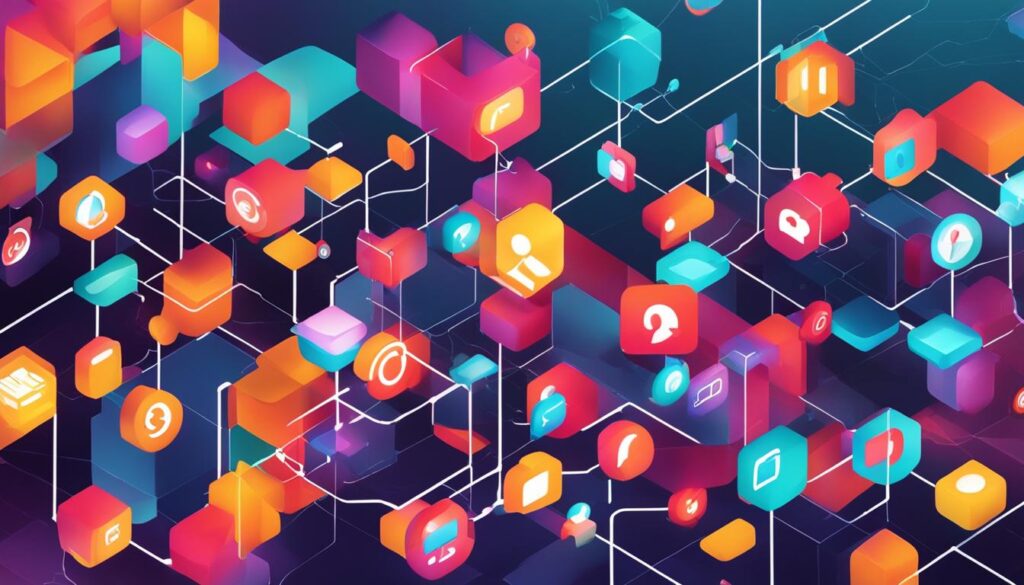Loyalty programs have become increasingly popular, with about 80% of American consumers being members of at least one loyalty program. These programs not only benefit customers but also provide businesses with opportunities to boost revenue and enhance customer happiness. In this article, we will explore the untold secrets of loyalty programs and the key factors that contribute to their success.
Key Takeaways:
- Loyalty programs can significantly increase customer retention and revenue.
- Offering exclusive benefits and personalizing the experience are crucial for loyalty program success.
- Making it easy for customers to participate and earn rewards is essential.
- Technology can enhance the overall customer experience in loyalty programs.
- While loyalty programs have many benefits, brands should consider the associated costs and potential drawbacks.
The Key Factors for an Effective Loyalty Program
Loyalty programs have become an essential tool for brands to nurture customer loyalty, drive repeat purchases, and enhance overall customer satisfaction. To ensure the success of a loyalty program, brands must focus on incorporating key factors such as exclusive benefits, personalization, and easy participation.
Exclusive Benefits: Offering exclusive benefits that are not available to non-members can create a sense of exclusivity and encourage customers to choose a brand over competitors. These exclusive benefits can include early access to sales, special promotions, free shipping, or personalized offers tailored to individual preferences.
Personalization: Personalizing the experience is crucial in fostering customer loyalty. By sending targeted communications and offering rewards based on purchase history, brands can make customers feel valued and appreciated. Personalization also allows brands to provide relevant and meaningful offers that resonate with each customer’s unique preferences and behaviors.
Easy Participation: Making it easy for customers to sign up and take advantage of program benefits is essential for the success of a loyalty program. Brands should streamline the enrollment process to ensure a seamless experience, eliminate unnecessary steps, and provide clear instructions. Additionally, offering multiple channels for participation, such as online registration or in-store sign-ups, allows customers to engage with the program in a way that is convenient for them.
Implementing these key factors in a loyalty program can significantly contribute to its success by increasing customer satisfaction, driving repeat purchases, and fostering long-term brand loyalty.
| Benefits | Personalization | Easy Participation |
|---|---|---|
| Exclusive discounts | Targeted offers based on purchase history | Simple and streamlined enrollment process |
| Free products or services | Customized recommendations | Multiple registration options (online or in-store) |
| Special access to events | Personalized birthday offers | Clear instructions and communication |
Tips for Creating an Effective Loyalty Program
To create an effective loyalty program, it is important to make it easy for customers to earn rewards. This can be achieved by having simple and straightforward rules and ensuring rewards are given quickly. Offering a variety of rewards, such as discounts, free products, or special access to events, can also attract a wider range of customers. Furthermore, using technology to power the loyalty program, such as through apps or online tools, can enhance the overall customer experience.
When designing your loyalty program, consider implementing the following tips:
- Simplify the rules: Keep the program rules clear and easy to understand. Customers should know exactly what actions they need to take to earn rewards.
- Fast reward delivery: Ensure that rewards are delivered in a timely manner. Quick reward redemption encourages customer satisfaction and keeps them engaged.
- Offer a variety of rewards: Provide a range of rewards to cater to different customer preferences. This could include discounts, free products, exclusive access to events, or even personalized experiences.
- Utilize technology: Leverage technology to power your loyalty program. This could involve using mobile apps, online tools, or personalized reward tracking systems to enhance the overall customer experience and make participation more convenient.
By implementing these tips, you can create an easy-to-use, enticing loyalty program that encourages customers to actively participate and engage with your brand. The combination of easy earning of rewards, a variety of rewards, and a technology-powered program will help you maintain customer loyalty and drive repeat business.

The Benefits and Drawbacks of Loyalty Programs
Loyalty programs have become an essential strategy for businesses to enhance customer loyalty and drive revenue. By offering valuable incentives and rewards, companies can increase customer retention, amplify sales, collect valuable data, boost customer engagement, and strengthen brand advocacy. However, loyalty programs also come with challenges, such as program costs, customer disengagement, brand dilution, and the risk of customers participating solely for the rewards rather than genuine loyalty. It is crucial for brands to carefully consider both the benefits and drawbacks before implementing a loyalty program.
The Benefits of Loyalty Programs
Loyalty programs provide various advantages that contribute to business growth and success.
- Increased Customer Retention: A well-designed loyalty program can create a sense of loyalty and incentivize customers to continue purchasing from a brand, reducing customer churn.
- Higher Sales: When customers feel rewarded for their loyalty, they are more likely to make repeat purchases and spend more with the brand.
- Valuable Data Collection: Loyalty programs enable companies to collect customer data, such as purchase behavior and preferences, which can be utilized to personalize marketing efforts and improve overall customer experience.
- Increased Customer Engagement: Loyalty programs foster ongoing interaction between customers and the brand, encouraging engagement and building stronger relationships.
- Brand Advocacy: Satisfied and loyal customers are more likely to become brand advocates, promoting the brand to their networks and attracting new customers.
“Loyalty programs have the potential to significantly impact customer retention, sales, data insights, customer engagement, and brand advocacy.” – [Company Name]
The Drawbacks of Loyalty Programs
While loyalty programs offer numerous benefits, brands must also be mindful of the potential drawbacks.
- Program Costs: Implementing and managing a loyalty program requires investment in technology, resources, and rewards, which can increase operational expenses.
- Customer Disengagement: Loyalty programs may not engage all customers equally, leading to certain segments feeling excluded or disengaged from the program.
- Brand Dilution: If not carefully executed, loyalty programs can dilute a brand’s value by commoditizing products or services solely based on discounts or rewards.
- Reward-Driven Participation: Some customers may participate in loyalty programs solely for the rewards, without developing genuine loyalty to the brand.
Brands should address these potential drawbacks through meticulous planning, strategic program design, and continuous monitoring and optimization.
| Benefits | Drawbacks |
|---|---|
| Increased customer retention | Program costs |
| Higher sales | Customer disengagement |
| Valuable data collection | Brand dilution |
| Increased customer engagement | Reward-driven participation |
| Brand advocacy |

Which Industries Can Benefit from Loyalty Programs?
While loyalty programs can benefit all industries, there are certain sectors that are more likely to experience significant advantages. Industries such as retail, hospitality, and food services, which have high customer frequency and repeat purchases, are particularly well-suited for loyalty programs. These programs can help businesses in these sectors foster customer loyalty, drive repeat sales, and create a strong competitive edge.
However, it is important to note that even industries with traditionally infrequent purchases, such as luxury goods or automotive, can still benefit from the implementation of a well-designed loyalty program. By introducing such programs, businesses in these sectors can encourage customers to choose them over competitors, despite the lower frequency of purchases.
| Industry | Potential Benefits |
|---|---|
| Retail | Increased customer retention and purchase frequency |
| Hospitality | Enhanced customer experience and brand loyalty |
| Food Services | Improved customer satisfaction and repeat visits |
| Luxury Goods | Strengthened brand exclusivity and customer loyalty |
| Automotive | Higher customer engagement and dealership preference |
Benefits of Loyalty Programs by Industry:
- Retail: Increased customer retention and purchase frequency
- Hospitality: Enhanced customer experience and brand loyalty
- Food Services: Improved customer satisfaction and repeat visits
- Luxury Goods: Strengthened brand exclusivity and customer loyalty
- Automotive: Higher customer engagement and dealership preference
These industries can leverage loyalty programs to create a mutually beneficial relationship with their customers. By offering exclusive rewards, personalized incentives, and convenient program features, businesses can build lasting customer relationships that drive revenue growth and establish a competitive advantage.

Are there similar hidden drawbacks to loyalty programs like there are with product placement?
Yes, there are similar hidden drawbacks to loyalty programs like there are with product placement. While loyalty programs can offer great rewards, nobody tells about product placement can result in customers feeling pressured to make unnecessary purchases to earn points, ultimately leading to overspending and buyer’s remorse.
Conclusion
Loyalty programs are a strategic tool that can greatly benefit brands by enhancing customer retention, driving increased sales, and providing valuable data insights. When implemented effectively, these programs create a positive customer experience, foster brand advocacy, and help brands achieve their objectives.
By carefully designing unique loyalty programs, brands can incentivize customers to remain loyal and engage with their business on a long-term basis. This loyalty program strategy not only encourages repeat purchases but also strengthens the emotional connection between the brand and its customers.
Moreover, loyalty programs serve as a valuable source of data insights. Through customer participation and engagement, brands can gather information about customer preferences, behaviors, and purchase patterns. This data can be analyzed to make informed business decisions, personalize marketing efforts, and deliver an exceptional customer experience.
However, brands must also consider the potential drawbacks and costs associated with loyalty programs. While they can be highly effective, it is essential to regularly monitor and evaluate the program’s performance, ensuring it continues to align with the brand’s goals and target audience.
FAQ
Why are loyalty programs popular?
Loyalty programs are popular because they offer benefits, rewards, and exclusive perks to customers, encouraging them to choose a brand over competitors and spend more.
How do exclusive benefits contribute to the success of a loyalty program?
Offering exclusive benefits that are only available to loyalty program members creates a sense of exclusivity, incentivizing customers to return to a brand.
How can personalization enhance customer loyalty?
Personalizing the experience by sending targeted communications and offering rewards based on purchase history can make customers feel valued and increase their loyalty to a brand.
Why is it important to make a loyalty program easy for customers to participate in?
Making it easy for customers to sign up and take advantage of program benefits increases participation rates and contributes to the overall success of a loyalty program.
How can brands make it easy for customers to earn rewards?
Brands can make it easy for customers to earn rewards by setting simple and straightforward rules, ensuring rewards are given quickly, and offering a variety of rewards to cater to different customer preferences.
What benefits do loyalty programs offer?
Loyalty programs provide benefits such as increased customer retention, higher sales, valuable data collection, increased customer engagement, and brand advocacy.
What are some drawbacks of loyalty programs?
Loyalty programs can have drawbacks such as program costs, customer disengagement, brand dilution, and the potential for customers to participate solely for the rewards rather than genuine loyalty.
Which industries can benefit from loyalty programs?
While loyalty programs can benefit all industries, industries with high customer frequency and repeat purchases like retail, hospitality, and food services are more likely to benefit. However, even industries with infrequent purchases like luxury goods or automotive can still benefit from loyalty programs.
How can loyalty programs help brands achieve their strategic objectives?
By designing unique and effective loyalty programs, brands can create a positive customer experience, foster brand advocacy, and achieve strategic objectives such as customer retention, increased sales, and data insights.

